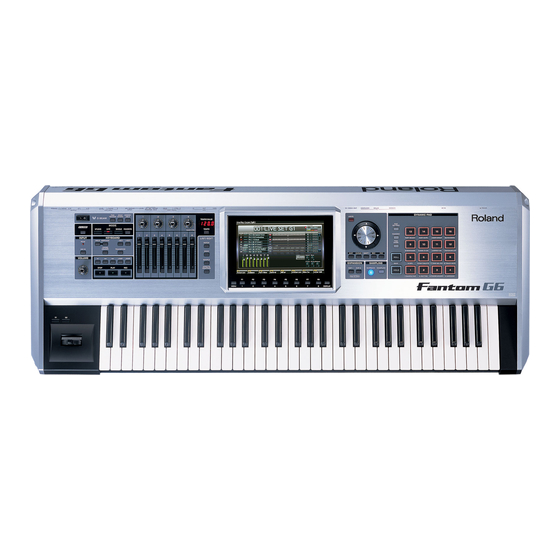
Roland Fantom G6 Features Manual
Workstation keyboard
Hide thumbs
Also See for Fantom G6:
- Quick start manual (48 pages) ,
- Features manual (24 pages) ,
- Workshop manual (22 pages)
Advertisement
Quick Links
Workshop
®ÂØÒňÎ
®
Fantom-G
Workstation Keyboard
Editing Fantom-G Patches and Rhythm Sets
© 2009, 2010 Roland Corporation U.S.
All rights reserved. No part of this publication may be reproduced in any form without the
written permission of Roland Corporation U.S.
FGWS06
1
Advertisement

Summary of Contents for Roland Fantom G6
- Page 1 ®ÂØÒňΠ® Fantom-G Workstation Keyboard Editing Fantom-G Patches and Rhythm Sets © 2009, 2010 Roland Corporation U.S. All rights reserved. No part of this publication may be reproduced in any form without the written permission of Roland Corporation U.S. FGWS06...
-
Page 2: About This Booklet
Right click possibilities, and sound-design opportunities. Each Fantom-G Workshop Series booklet focuses on one Fantom-G topic, and is intended as a companion to the Fantom G6/G7/G8 Owner’s Manual. Scroll wheel This booklet requires Fantom-G Operating System v1.30 or higher. You can download the latest Fantom-G O.S. - Page 3 Patches A patch may or may not use all four of its tones, depending on the complexity of the sound its programmer is trying to achieve. How a Patch Works If you want to edit patches or create your own, you’ll need to understand A tone doesn’t have to play a stereo waveform or sample, or two mono what makes a patch tick, so to speak.
- Page 4 The first patch-editing screen appears. Activating and Selecting Tones To turn tones on or off on a patch-editing screen, click F8 (Tone Sw/Sel) to show the Tone Switch/Select F buttons at the bottom of the screen. • To turn each of the four possible tones on or off— click the desired F1-F4 (Sw) button.
- Page 5 • Pro Edit patch editing— contains all of a patch’s parameters, allowing you The TVF Zoom Edit Screen to dig into a patch down to its tiniest details. You’ll want to use Pro Edit when you’re building a patch from scratch. The TVF—for “Time Variant Filter”—can remove selected frequencies from a tone’s waveform, sample or multisample, as described on Page 98 in the Owner’s Manual.
- Page 6 The TVA Envelope Zoom Edit Screen The LFO1 and LFO2 Zoom Edit Screens The TVA Envelope—for “Time Variant Amplifier” envelope—Zoom Edit On each of these Zoom Edit screens, you can adjust the patch’s LFO. An screen allows you to automatically shape a tone’s volume as a note plays, as LFO—or “low frequency oscillator”—can add cyclical variations to your explained on Page 101 in the Owner’s Manual.
- Page 7 • TVA Env (TVA Envelope)— The TVA envelope allows you to automatically The Pro Edit Parameters shape a tone’s volume as a note plays. See Page 101 in the Owner’s In the Pro Edit patch-editing screens, you’ll find all patch-wide and tone- Manual.
-
Page 8: Rhythm Sets
Patch-Editing Tools Tone Copy If you’d like to copy the settings from one tone to another within the same On either the Zoom Edit or Pro Edit screens, you can click F4 (Util Menu) patch—or “borrow” the settings of a tone from another patch—use Tone to display the Patch Utility Menu containing a list of helpful patch-editing Copy to open the Patch Tone Copy window. - Page 9 If the rhythm set is on the: A drum key may or may not use all four of its waves, depending on the • keyboard— set the Part parameter to Part 1, the keyboard part. complexity of the sound the programmer is trying to achieve. •...
- Page 10 On the display, use F1 (Group/Up) to select the General group of General parameters name the currently selected drum key, assign it to parameters. a mute group, set its controller response, and turn its One-Shot mode on or off. See Page 117 in the Owner’s Manual for more. •...
- Page 11 Rhythm Set-Editing Tools with patch editing programming, Fantom-G provides some helpful rhythm set editing tools you can display by clicking F4 (Util Menu) on any Pro Edit or Zoom Edit rhythm-set editing screen. Rhythm Set Initialize You can audition drum keys in the selected Source set by clicking F6 You can start programming a rhythm set from the default one built into (Compare) so it lights, and then playing the rhythm set’s drum keys on the Fantom-G by selecting this operation in the Rhythm Set Utility Menu...
- Page 12 The End We hope you’ve found this workshop helpful. Keep an eye out for other Fantom-G Workshop booklets available for downloading at www.RolandUS. com.
















Need help?
Do you have a question about the Fantom G6 and is the answer not in the manual?
Questions and answers